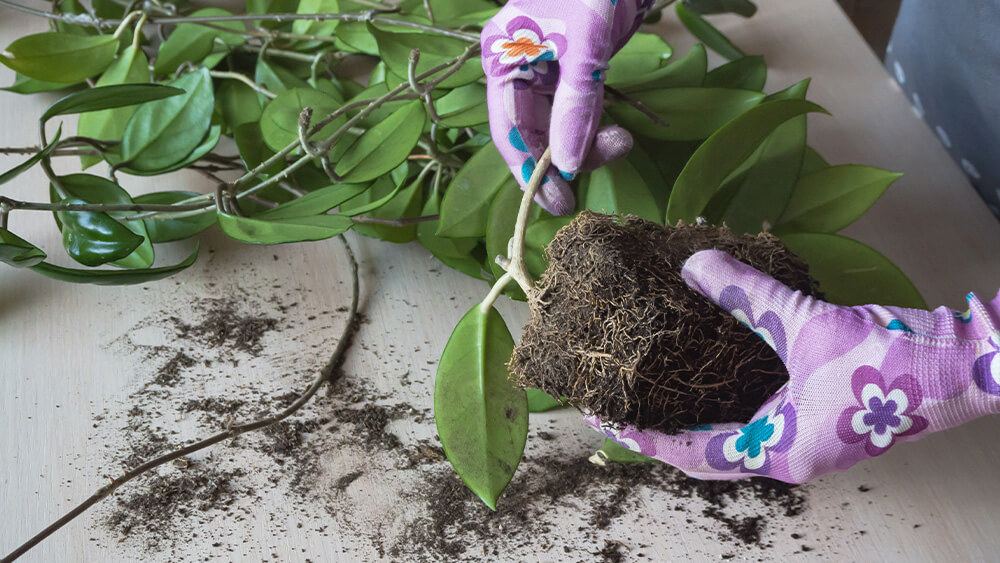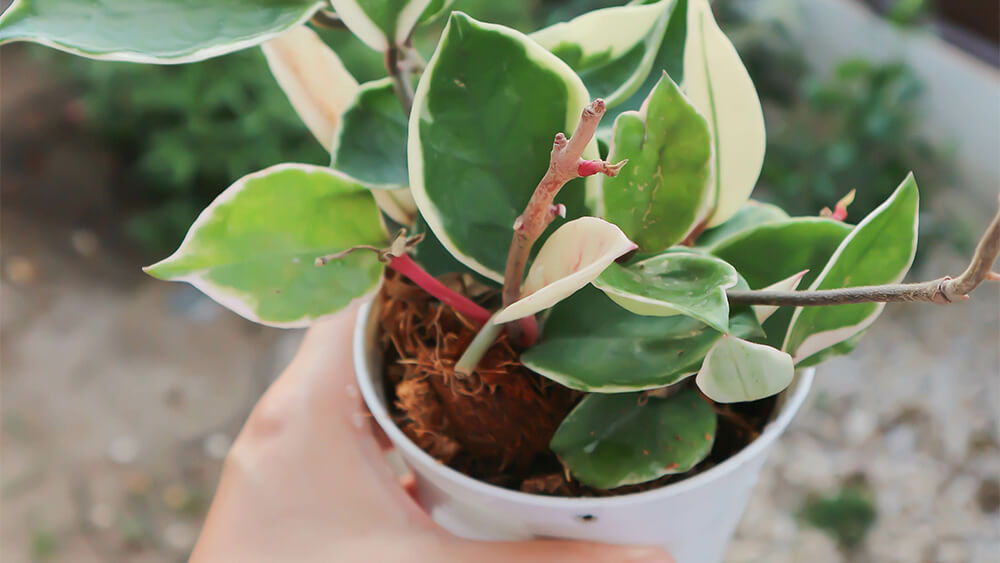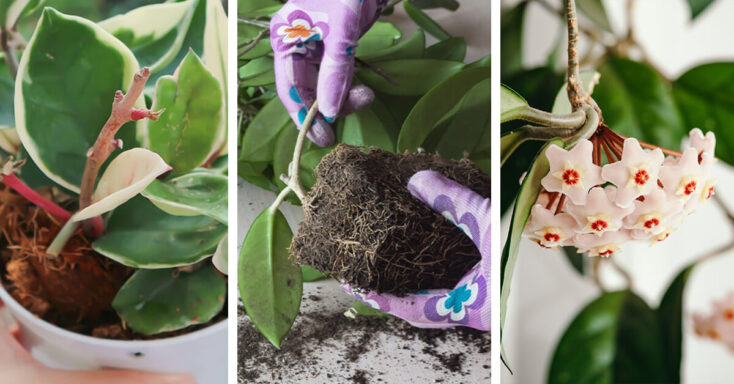There is something completely elegant about Hoya Plants. They look like fine bone china, colored in scarlet and wine. Once they open, the Hoya flower releases a delicate fragrance that’s not imposing. The perfume is alluring when you catch it in the wind. This guide will cover everything about Hoya plant care so you can make it thrive in your garden!
Hoya flowers are five-pointed double stars. They’re so perfect they almost look artificial. Once you get up close, however, you see they are, indeed, a genuine treasure.
Key Takeaways
- Outdoor Hoya plants are not overly difficult to grow and care for.
- You need a good soil mix amended with perlite for good air circulation for your Hoya to thrive.
- Do not water your Hoya plant’s leaves. Apply water at the bottom of the plant.
- The scent of hoya flowers has chocolate, citrus, and vanilla notes.
Hardy Hoyas
Hoya originated in Southeast Asia and Australia. They dot the countryside in the oddest location, including the Himalayan Mountains! Hoy has several hundred species, and in an odd twist of fate, milkweed is a kissing cousin.
The flower colors on Hoyas vary greatly. An overachieving Hoya may produce 3-inch flowers and bear as many flower bundles as 70 (Hoya coriacea). If you are tight on space in your yard, you’ll appreciate the fact that Hoyas do well in hanging baskets or on a trellis using vertical space.
Hoya plants received their name from a gardener, Thomas Hoy. He worked under the Duke of Northumberland. In his work, he began placing a spotlight on this glorious plant. Robert Brown, a botanist, discovered Hoyas in the late 18th century.
Everything You Need to Know About Outdoor Hoya Plant Care
You won’t really have to fuss much in caring for your outdoor hoyas. They require little in the way of effort to thrive. Keep the word “moderation” in your mind with Hoyas, and you’ll do just fine: specifically moderating water and sunlight. Under-watering and over-watering will kill your plants. Too much or too little sun will damage them.
If you are growing your hoyas in outdoor containers, the best way to help with potential over-watering is to have a plant pot with suitable drainage holes. More than one is preferable. You may also have to amend your soil with perlite to ensure your Hoya gets proper air circulation.
What about sunlight? Check your landscape or garden at different times of the day. You’re looking for a spot where the Hoya gets filtered light. Direct sunlight will burn the leaves.
Watching Hoyas grow is fun and captivating. They grow but one leaf at a time. You can watch the tiny bud grow to perfection. As Hoyas age, they develop woody trunks, giving the plant more character. Because Hoyas enjoy climbing, you can train your plant in specific ways for visual appeal.
Hoya Necessities
When you look at a hoya, their waxy foliate immediately stands out. Because of that configuration, you might think it’s a succulent, but it’s not. Hoya cannot handle harsh afternoon light. Low light isn’t much better. It leads to a lack of blooming.

Humidity: You may not like humidity, but hoyas love it. Outdoors it’s challenging to regulate. Three things you can do to create humidity are misting, grouping, and mulching. Take out your handy misting bottle and treat the Hoyas regularly. Also, plant hoyas close to each other. In a group, the plants absorb the moisture from the other plants in that space. Mulch around the bottom of the plant. The mulch holds water, which slowly dissipates as humidity.
Fertilizer: You want a fertilizer formula with a balanced NPK ratio (2-2-2). It benefits hoyas by supporting strong leaf growth.
Soil: Most garden soil needs some type of amendment to foster Hoyas. Organic cactus mix and orchid mix works quite well. Notwithstanding, you could, alternatively, add perlite to some good potting soil into the mix.
Water: In the warm months, don’t water your hoyas with icy water. Room temperature is fine. This means you may have to attend outdoor hoyas using a watering can. Set up a schedule based on how often you find the soil starting to dry out. Sparingly add water at that time.
Examining Hoya flowers is delightful. They look like tiny artistic endeavors. Tiny blooms appear in umbrellas (clusters). There’s plenty of room to spare. The Clusters may contain literally dozens of flowers. Depending on the cultivar, the flowers develop in shades of pink, orange, green, white, and wine. The blossoms last for weeks.
Hoya as Part of a Garden or Landscape Project
When you want to include hoyas in your gardening project, you have a vast array of cultivars from which to choose. Here are a few you might like.
- Australis: Massive wax leaves in forest green. The foliage measures about 4 inches across. Leaves have silver specks. Australis is a hardy grower. The flowers are pink and red.
- Bandaensis: A perennial creeper, sturdy with glossy-green leaves. The larger species can grow to a dramatic 59 feet. The most common color flower on these plants is pink (or peach), but you may find some with dark red, orange, and near black flowers.
- Bella: This Hoya is a show-stopper. It boasts drooping branches adorned with dark green leaves. The flowers produced by Bella are white, offset by purple centers. The nickname for Bella is the Honey Plant. Mature size around 10 feet.
- Carnosa: Carnosa is well known in the hoya world. It has oval, deep green leaves. The flower spray has pink centers crowned in red. You can find carnosa variegata, with cream-edged leaves—dainty, sweet, and low maintenance.
- Compacta: Drought Resistant. Compactica produces blush-pink flowers with tiny white centers. It’s easily recognizable thanks to having curling foliage. Mature size: 6-20 feet.
- Coronaria: Coronaria has curvy leaves with hairy undersides and a pale yellow, fine edge. Flowers measure over an inch. If you have a rock garden, it’s the perfect spot for Coronaria.
- Curtisii: Delineated by small leaves dotted with silver. The flowers are uniquely lime green, slowly turning to wine red, and finally, a star of yellow in the center. Mature plant spread: 2-3 feet.
- Imperialis: A very thirsty Hoya, Imperialis has an impressive red outer flower and an inner flower bursting with white. Prefers a trellis. It won’t flower until mature (2 years).
- Kentia: It may be challenging to find a Kentia, but if you do, grab it! This hoya has uniquely long, pointed leaves. The flowers are reddish purple. Slow to blossom, but the fragrance is sublime and worth the wait.
- Kerrii: Also known as the Sweetheart Hoya because of its sweet heart-shaped leaves measuring 2.5 inches. This will grow to be about 13 feet tall. When it blossoms in summer, the flowers grow in a star shape. Petals are white on the outside, followed by a circle of red and a center of yellow.
- Krimson Queen: This hoya will need 7 hours of light daily, so plant accordingly. Note it does not like to be moved. Doing so can cause shock. Leaves are green and cream along trailing vines.
- Lacunosa: Lacunosa flowers all year, smelling of cinnamon. The blossom clusters look almost poofy because they’re so tightly gathered. Colors: exterior white, followed by buttercup yellow, and finally a gold center.
- Latifolia: Sometimes called mountain laurel, latifolia boasts coppery leaves shaped like eggs. Its mature size varies between 10-20 feet. Bell-shaped blossoms arrive between May and June, having pale pink to deep rose coloring.
- Linearis:The linearis has long, fuzzy tendrils that shape into something akin to a leaf curtain. It features bundles of small, white flowers.
- Longifolia shepherdi: Bean pod-shaped leaves that grow in pairs and have an indent making them partially folded. Its flowers are white with an accent of wine.
- Motoskei: The vine blossoms with pink-white flowers with maroon centers. They produce aroma at night. The fuzzy pale-green leaves are elliptical and dotted with silver.
- Multiflora: Also called Shooting Star Hoya because of the shape of the flowers. This plant has yellow-centered leaves. Silver-pink blotches decorate dark green foliage. When it blossoms, the flowers are deep wine with silver-blush crowns.
- Wayetii: Red-margined green leaves and yellow-white patterns. It flowers in spring with mauve blossoms.
Hoya Flower Symbolism: Spiritually speaking, Hoya supports discovering one’s fate and embracing fulfillment. It clears out blockage to our higher self and creates an inner stillness—an excellent flower for meditation rooms.
Watering Techniques for Outdoor Hoya
Hoya plants don’t appreciate over-wet soil or over-dry. When the first inch of soil around your Hoya is dry, it’s time for a good soaking. Don’t water again until the soil dries. You want to make sure the entire root system receives moisture.
You will have to adjust watering frequencies based on the weather. While it seems obvious, water more when it’s hot, and less when there’s a lot of rain. Always water your plants at the base. Don’t let the leaves get wet.
Because your Hoya appreciates room-temperature water, consider using a filled container to your plant when it needs water.
Hoys have several names, including wax flower, porcelain flower, wax vine, and honey plant. Porcelain flower refers to the delicate impression hoy blossoms make. The most popular Hoya is carnosa and all its cultivars. Carnosa translates as “fleshy.”
Outdoor Hoya Potting and Repotting

If you pot your Hoya plant, there will come a time when it outgrows that home. There are signs your plant is ready for repotting:
- When you notice a mat of roots appearing on the surface of the soil, it’s definitely time.
- If the soil dries out more quickly than usual, the plant may be root-bound.
- When the plant growth slows dramatically, it indicates the Hoya needs more space.
- Seeing roots sneaking out of the drainage holes means they’re looking for space.
If you still have uncertainties, gently remove the plant from its pot and check the rootball.
While it’s sometimes hard to find due to rarity, Hoya carnosa compactica is a very popular Hoya. It has a rope-like appearance thanks to the foliage’s twists and turns. Other Hoya have trailing vines. Compactica bears pink blossoming stars filled with fragrance from early spring through summer.
Another rare Hoya is lacunosa. This plant bursts with tiny, lightly sweet-scented flowers. The foliage has a lance shape in deep green.
Hoya Fitchii are great finds. People love the copper-colored flowers with pink centers. Spring is the blossoming season. Foliage is light green with white veins.
Krimson Princess is a variegated cultivar with pink and white flowers. When new vines and foliage appear, they radiate with bright pink. Finally, Hoya polyneura is the “fishtail” Hoya with long leaves resembling a mermaid tail. The flowers are waxy yellow and red blossoms.
Pruning and Maintenance for Outdoor Hoya Plants
Prune in early spring before your plants start active growth. Don’t remove stems with no leaves. Flowers will grow on them. Because Hoya can become unwieldy, pruning does it good by encouraging lush foliage. Trimming controls their size, which is especially helpful in small yard spaces.
Get rid of dead parts for the Hoya’s overall health by decreasing the chance of pets and disease spreading. This can get messy because latex often spills from the stems. When you remove the first few inches of a stem, it creates a bushier plant. The treatment improves the chances of more blossoms, too.
Always err on the side of caution. Make sure you only cut branches when they’re obviously damaged or unhealthy. When the plant is so overgrown it blocks light or air to the whole plant, you want to trim it.
Leggy Hoys: If your Hoya gets leggy, sometimes it’s from a lack of light. Look around to see if trees or other plants are blocking the sun. If so, try to cut them back. Once there’s more light, trim back the leggy stems.
Outdoor Hoya Blooming and Resting Periods

If possible, your Hoyas are better off in a cool, dark area indoors like a garage, entryway, or screen porch during winter. Otherwise, make sure they’re well protected. When Hoyas move into dormancy, reduce the water you give them. They only need just enough so the soil doesn’t dry out completely. Three months is a healthy resting time
You can propagate Hoya from cuttings at least 6 inches long with two nodes and 3-4 leaves. Put the cutting into a glass of water with only ¼ submerged (leaves above the water). Alternatively, stand it upright in dampened sphagnum moss. It will take a few weeks before roots form. At that point, you can transfer the baby Hoya into a crock until it’s a little larger for your garden.
Common Pests and Plant Diseases
There are a variety of issues that could harm your Hoya. With disease, there’s a fungal problem called Botyris blight. If your leaves become mushy, it may well be this disease. It requires treatment with copper fungicide.
Root rot is another development. Over-watering is the main culprit. Remove your plant from the soil and trim back sick roots. Return it to the soil, adding copper fungicide. There’s also sooty mold, sometimes called by aphids. You can wipe the mold off the leaves with a little dish soap.
Concerning insects, Hoyas are sappy plants, so they attract typical critters that eat sap, like mealybugs, scale insects, and spider mites. When you discover an infestation, give your plant a good spray with Neem. Insecticidal soap works too.
Watch for fuzzy insects on your hoya plant’s stems, leaves, and flowers. Those are mealybugs. Wipe the plant with rubbing alcohol and water. Scale insects, as the name implies, look like little scales on the leaves and stems of the Hoya. Like mealybugs, you can wipe off the plant with alcohol and water.
Signs of spider mites are little webs dotted around the Hoya. The best treatment is neem oil or an insecticidal soap.
Folk Medicine: Some Hoya species have medicinal applications in the Gonga, Guinea, and Samoa. The leaves become part of a soothing skin lotion useful for burns. There’s some evidence that H. carnosa has antiaging, antiwrinkle, and antibacterial properties.
Troubleshooting Common Outdoor Hoya Problems
- Dropping Leaves: Usually a sign of over-watering. Conversely, if the leaves shrivel, the plant isn’t getting enough water.
- Different colored leaves: Variegated Hoyas shaded in green and red are lively and healthy Browning or yellow Hoyas may mean you’re giving your plant too much water. Pay attention to the soil’s moisture before watering.
- Drying brown leaves happen when it’s too hot, or there’s not enough humidity.
Frequently Asked Questions About Hoya Plants Care and Keeping
Do Hoyas like sun or shade?
Yes. Hoyas need light to thrive, about two hours of direct sunlight first thing in the morning or evening. After that, indirect light is best. If they don’t get enough sun, they don’t produce flowers. If they get too much sun, the leaves may burn.
How do you care for a hoya plant indoors?
The first big step in caring for an indoor hoya is knowing your species. Each one has slightly different requirements. Look at specifications about light, drainage, and fertilizer. Adjust your care patterns based on what the plant tells you by observation.
How often do you water hoya?
Hoya plants should dry out between waterings. On average, water your Hoya every 1-2 weeks.
How do I get my hoya plant to bloom?
Getting your plant to bloom is like putting together a puzzle. You need to put it in the right soil and in the right spot. Attend watering protocols and feed it according to a balanced product’s direction. Be looking for insects or diseases that may nip blossoms in the bud. Remember, most Hoyas don’t flower until they’re at least 3 years old.
Why is my hoya growing but not flowering?
The variety of your Hoya determines its flowering timing. And some cultivars don’t blossom at all. If the plant is of suitable age and it’s still not flowering, it may lack light or proper nutrients.
Summary
Hoyas are fun plants with quirky-looking flowers. They’re fantastic for people with limited yard space because they can grow on trellises, freeing up other garden spaces for different plants. In this, hoya plants become a blossoming background for your landscape.


